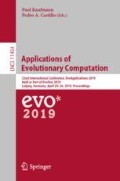Abstract
Sepsis is one of the leading causes of death in Intensive Care Units (ICU) world-wide. Continuous Petri Nets (CPNs) offer a promising solution in modelling its underlying complex pathophysiological processes. In this work, we propose a framework to evolve CPNs, i.e. evolve its places, transitions, arc weights, topology, and kinetics. This facilitates modeling complex biological systems, including activated signalling pathway in sepsis using limited experimental data. Inspired by Neuroevolution of Augmenting Topology (NEAT), which is adopted in Artificial Neural Networks (ANNs), our framework includes a genotype to phenotype mapping based on the CPN incidence matrix, and a fitness function, which considers both the behaviour of the evolving CPN and its emerging structural complexity. We tested our framework on ten different cases with different complexity structures. In the worst case, results show the NMSE less than \(2\%\) in the learning phase, and MSE of \(13\%\) in the validation phase. We applied our framework on real-world data from cell culture experiments, representing a biological pathway in sepsis. Using the output of these experiments, the proposed framework was able to evolve a CPN to model this pathway with an MSE value of \(10\%\) in the validation phase.
Access this chapter
Tax calculation will be finalised at checkout
Purchases are for personal use only
Notes
- 1.
Due to page limit.
References
Komorowski, M., Celi, L.A., Badawi, O., Gordon, A.C., Faisal, A.A.: The artificial intelligence clinician learns optimal treatment strategies for sepsis in intensive care. Nat. Med. 24, 1716 (2018)
Singer, M., et al.: The third international consensus definitions for sepsis and septic shock (sepsis-3). Jama 315(8), 801–810 (2016)
Martin, L., van Meegern, A., Doemming, S., Schuerholz, T.: Antimicrobial peptides in human sepsis. Frontiers Immunol. 6, 404 (2015)
Zechendorf, E., et al.: Heparan sulfate induces necroptosis in murine cardiomyocytes: a medical-in silico approach combining in vitro experiments and machine learning. Frontiers Immunol. 9, 393 (2018)
Abbass, H.A.: An evolutionary artificial neural networks approach for breast cancer diagnosis. Artif. Intell. Med. 25(3), 265–281 (2002)
Ahson, S.I.: Petri net models of fuzzy neural networks. IEEE Trans. Syst. Man Cybern. 25(6), 926–932 (1995)
Bapat, R.B.: Incidence matrix. In: Graphs and Matrices, pp. 11–23. Springer, London (2010). https://doi.org/10.1007/978-1-84882-981-7_2
Brownlee, J.: Clever Algorithms: Nature-Inspired Programming Recipes, 1st edn. Lulu.com (2011)
Huizinga, J., Clune, J., Mouret, J.B.: Evolving neural networks that are both modular and regular: hyperneat plus the connection cost technique. In: Proceedings of the 2014 Annual Conference on Genetic and Evolutionary Computation, pp. 697–704. ACM (2014)
Claycomb, W.C., et al.: Hl-1 cells: a cardiac muscle cell line that contracts and retains phenotypic characteristics of the adult cardiomyocyte. Proc. Nat. Acad. Sci. 95(6), 2979–2984 (1998)
Martin, L., et al.: Soluble heparan sulfate in serum of septic shock patients induces mitochondrial dysfunction in murine cardiomyocytes. Shock 44(6), 569–577 (2015)
Martin, L., et al.: Peptide 19-2.5 inhibits heparan sulfate-triggered inflammation in murine cardiomyocytes stimulated with human sepsis serum. PLoS ONE 10(5), e0127584 (2015)
Author information
Authors and Affiliations
Corresponding author
Editor information
Editors and Affiliations
Rights and permissions
Copyright information
© 2019 Springer Nature Switzerland AG
About this paper
Cite this paper
Hallawa, A. et al. (2019). On the Use of Evolutionary Computation for In-Silico Medicine: Modelling Sepsis via Evolving Continuous Petri Nets. In: Kaufmann, P., Castillo, P. (eds) Applications of Evolutionary Computation. EvoApplications 2019. Lecture Notes in Computer Science(), vol 11454. Springer, Cham. https://doi.org/10.1007/978-3-030-16692-2_17
Download citation
DOI: https://doi.org/10.1007/978-3-030-16692-2_17
Published:
Publisher Name: Springer, Cham
Print ISBN: 978-3-030-16691-5
Online ISBN: 978-3-030-16692-2
eBook Packages: Computer ScienceComputer Science (R0)

